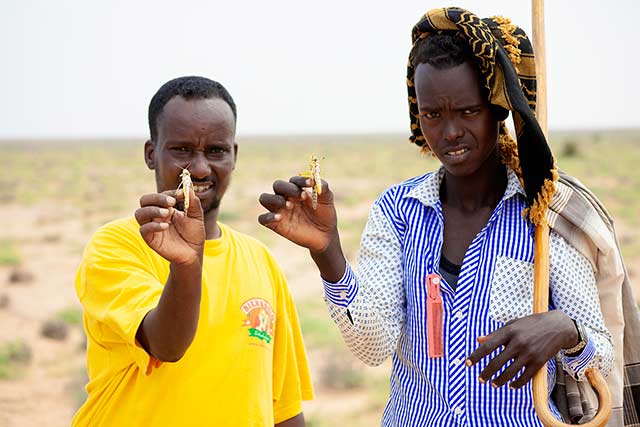
A worker from Somaliland’Äôs Ministry of Agriculture carries an Ultra-Low Volume (ULV) sprayer filled with bio-pesticide on his back as he sprays one of the breeding grounds for the desert locusts in Geerisa town, Lughaya District, some 350km north east of the capital Hargeisa, Somaliland. | Photo: EFE/EPA/ Daniel Irungu
The organization remarks that the scenario “remains very critical” in the Horn of Africa as the plague continues to increase in Somalia; Ethiopia; Kenya; Eritrea; Sudan; Yemen, and Saudi Arabia. In contrast, the FAO explains that “the situation remains calm in West Africa and southwest Asia.”

The United Nations Food and Agricultural Organizations issued an emergency alert on Monday as a new wave of desert locust invasions jeopardizes the livestock all across Somalia.
“Immature and mature swarms are present in the northwest between Boroma and Hargeisa while mature adult groups and swarms are present and breeding in the northeast and central areas of Mudug and Galgaduud. Hatching and band formation have commenced in the past few days, and more is expected in the coming weeks, including the northwest once egg-laying occurs,” the FAO explained on the alert.
The organization remarks that the scenario “remains very critical” in the Horn of Africa as the plague continues to increase in Somalia; Ethiopia; Kenya; Eritrea; Sudan; Yemen, and Saudi Arabia. In contrast, the FAO explains that “the situation remains calm in West Africa and southwest Asia.”
The FAO has described the current desert locust plague in East Africa as “a scourge of biblical proportions” that speed food insecurity across the region.
On October 15, the United Nations agency warned that at least 2.1 million Somalis could face acute hunger if enough humanitarian assistance is not provided until December. Although the authorities are rushing to stop the plague, the forecast for the coming months is not optimistic.
The FAO points out that the new wave of swarms “moving from eastern and central regions of the country to southern states, can cause disaster and seriously impact the agricultural fields and the livelihoods and food security of farmers in these vulnerable regions.”

